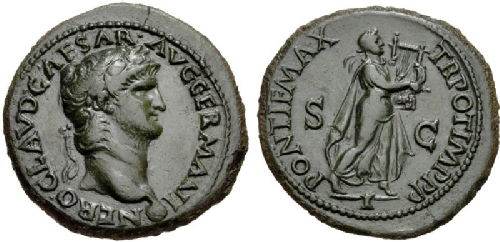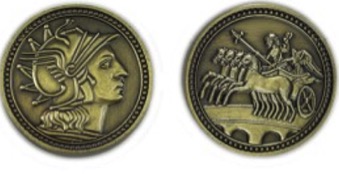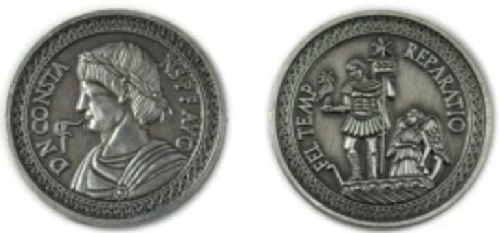All 2 entries tagged Nero
No other Warwick Blogs use the tag Nero on entries | View entries tagged Nero at Technorati | There are no images tagged Nero on this blog
November 01, 2018
Fantasy Coins

This coin looks like a Roman coin. It is circular, it bears the head of the emperor, in this case Nero, and the legend (the writing on the coin) appears around the head. It is made of copper rather than the mixed-alloy bronze that was common in the Roman imperial period. However, the intent of the maker is to make a low value denomination. The lettering S C on the reverse (tails side) is a common feature for Roman issues in bronze, and the appearance of monuments, like the Ara Pacis in this case, is well attested. However, this is not a Roman coin, nor is it a modern imitation. This is a Fantasy coin; a coin reflecting the currency of a fantasy or an alternative history world.
Fantasy coins are produced by a number of different modern companies in response to the explosion of interest in fantasy games, such as Dungeon and Dragons. The coins can reflect specific worlds, such as Westoros (the world of Games of Thrones) or ancient Rome. Other ranges relate to generic fantasy worlds, particularly a specific racial or cultural group in that world. Elvish, dwarvern, barbarian, dragon and orcish communities are among the many catered for. Futuristic coins, representing the coins of imagined galactic empires, are also produced. In order to relate the coin to the subject matter, the images on the coin and more occasionally its shape are utilised. Such images are based on popular tropes related to the fantasy race. Dwarvern coinage for instance tend to show anvils, hammers and bear Nordic runes, ultimately derived from a Norse description of dwarfish smiths in the Prose Edda, a medieval text detailing Scandinavian myths. Orc coins often bear weapons or warriors, reflecting the original inspiration of orcs from Tolkien as creatures obsessed with war.
In many cases, a specific range of Fantasy coins is not tied to a particular game. The generic imagery is used so that the pieces can be accommodated in a number of different settings, allowing for a wider array of customers. The general audience of these coins are gamers and curiosity collectors, though these are often not separate groups. Players of “roleplaying” games, in which the players control characters in an imagined setting, with one player known by various names (Game Master, Dungeon Master or Keeper among many others) guiding the story. In these contexts, props are often utilised. These primarily consist of miniature figures representing the characters and their opponents, but increasingly other props are utilised to increase the immersion in the game. This is particularly evident in the real-world equivalent of role-playing, larping (otherwise known as live-action roleplaying) in which the participants physically portray their characters through costume and acting. Props are particularly valued in such settings, and the organisers of these events often produce their own coins. There are even events where complex denomination systems accompany the coins. For these groups, the coins are often bought in bulk. However, individual coins are also available for purchase. These would not be suited to games that require many coins, so these coins have a premium on their artistic value. As a result, Fantasy coins tend to be larger than most modern coins, and they often bear high quality designs. The Ancient Greeks also produced large coins with high quality images, so the use of coins as aesthetic pieces marks a continuation of an ancient tradition.
One would think that the coins would be highly unusual, as they are products of imagination. However, most fantasy coins are almost identical to the coins produced in the ancient period. The majority of fantasy coins are depicted as round objects, with an image on each side. Most ranges of fantasy coins have three separate denominations, with a gold, silver and copper issue. The only differences are the subject matter of images upon the coins and that they are not usually made of precious metal (like gold or silver), unlike the ancient coins which were intrinsically valuable in their own right. Since coinage began in 7th century BC Turkey, coins in the western world have retained the same features. Even Bitcoin is represented as a circular object, despite its digital form itself having no physical shape. Fantasy coins, for all the imagination behind them, are slaves to the trope. There are a few attempts to get away from round coinage for particularly exotic cultures, with some coins represented as moons, axe heads or as hexagons. In most cases, however, the producers of these coins are bound to their customers’ understanding of what a coin should look like.
Returning to our Fantasy Coin example, the coin copies a Roman issue in terms of its iconography (e,g, RIC 1 527). It is not, however, an imitation. The size of the original Roman denomination, an as, is not copied. As with other fantasy coins, the Nero coin is part of a series of gold, silver and copper coins, classed under the title “Roman”. As the smallest denomination, the coin is the smallest size in the series, whereas the gold coin is the largest coin of the set. In the ancient world, the size difference in coins was usually unnecessary; gold coins were intrinsically more valuable due to their metal content, so even the smallest gold coin was more valuable than the largest bronze coin and bronze coins were generally larger in antiquity. However, for modern Fantasy coins it would seem that bigger is better, so the highest denomination is afforded the largest size, and thus the greatest prestige. Within the series is a silver coin depicting a Constantine issue, and a gold coin bearing the Republican head of Roma, the titular goddess of Rome, with Jupiter riding a chariot alongside Victory on the reverse. The latter image was prominently featured on silver coins struck during the Roman Republic; the placement of the image on a gold coin here indicates that the modern manufacturer saw this image as worthy of a higher value.
|
|
|
Historical accuracy is not the intention behind these coins. What matters is the modern audience’s perception of what a coin is and what Roman culture was. Hence the more valuable coins are larger and the images chosen are ones that reflect “Roman-ness”. Hence emperors, monuments and famous gods are preferred over other images, like the many personifications of lesser deities that decorate the majority of ancient Roman coins. However, the manufacturers have chosen to imitate Roman coins rather than create their own images, so there is a modern desire for “authenticity” in some sense that the producers of these pieces are accommodating. This is not always the case; Fantasy Spartan coins exist, yet in reality the Spartans had no coins. As a result, standard pieces of Greek military equipment, like the Corinthian style helmet, are utilised for the iconography of these pieces.

The expansion in the Fantasy coin trade represents a continuation of coins as an art form. From their beginnings, coins in Europe bore high quality designs. The Rennes Patera show that certain individuals collected coins and valued them for the iconography upon them. There is little difference here.
Fantasy coins have yet to receive any major academic study. Yet studying these coins in an academic fashion is of great use in understanding modern conceptions. This is particularly true of the “historical” ranges of Greek and Roman coins. As a form of reception studies, one can see what particular images a modern audience considers as being “most Roman” or “most Greek”. The more fantastical ranges are also of interest, as it would be curious what real-world influences are attributed to these fictional races. Overall, the production of Fantasy coins shows that in the modern world where most transactions are carried out online or through credit, coins continue to attract interest.
 |
This month's coin was written by David Swan. David is a postgraduate researcher at the University of Warwick. His thesis examines coinage and hoarding patterns across the Channel in Iron Age Europe. He specialises in Iron Age (otherwise known as Celtic) coinage.
September 20, 2013
Offending Images, or Nero plays the lyre
Writing about web page http://www.youtube.com/watch?v=NnOPQSu3DM0
'A picture is less like a statement or speech act, then, than like a speaker capable of an infinite number of utterances. An image is not a text to be read but a ventriloquist's dummy into which we project our own voice. When we are offended by what an image "says", we are like a ventriloquist insulted by his own dummy.'
Mitchell, What do Pictures Want?, p. 140
'He placed the sacred crowns in his bed-chambers around the couches, as well as statues representing him in the guise of a lyre-player; and he had a coin too struck with the same device.'
Suetonius, Nero 25.2
In the book What do Pictures Want, Mitchell makes the point that images are, in and of themselves, rarely offensive. Rather it is the individual's interpretation of an image, or a description or verbal report, that makes the image objectionable. Thus a description of a picture, given to people who may not have actually seen the image itself, is enough to offend the viewer, or, in this case, hearer.
 |
| Coin of Nero showing a lyre player |
Reading this reminded me of the various ancient mentions of 'offensive' numismatic iconography. These instances are often an interpretation of a coin type that may have differed from the message intended by the creator. Perhaps the most famous example is the coin of Nero playing the lyre, mentioned by Suetonius. There is a coin of Nero showing a figure playing the lyre, but the coin itself does not necessarily declare the figure as Nero - the artist may have intended, for example, to depict the god Apollo. It was the individual viewer, or verbal reports or interpretations of the image, that transformed it into a statement of Nero's delinquency. It was the verbal and written discourse that accompanied the image that gave offense. A reminder that as much as we may focus on the 'power of images', words have a vital and influential role in how images are viewed.
(Image reproduced courtesy of Classical Numismatic Group Inc., (Electronic Auction 276, lot 379) (www.cngcoins.com)


 Clare Rowan
Clare Rowan

 Please wait - comments are loading
Please wait - comments are loading

 Loading…
Loading…

